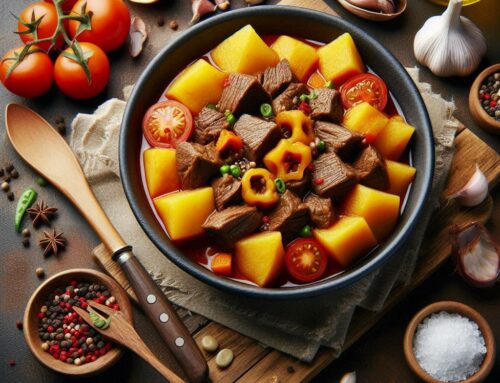
Understanding Cassava Flour: What Makes it Unique?
Cassava flour is gaining popularity as a versatile and gluten-free alternative to traditional wheat flour. Derived from the root of the cassava plant, this flour boasts unique properties that set it apart in the world of baking and cooking. One of its most notable characteristics is its ability to mimic the texture and behavior of wheat flour, making it an excellent substitute for those with gluten sensitivities or celiac disease.
When comparing cassava vs. wheat flour, it’s important to note that cassava is naturally gluten-free, which makes it suitable for a variety of dietary needs. Unlike many other gluten-free flours that require blending with other ingredients to achieve a desirable texture, cassava flour can often be used on its own in recipes without compromising taste or quality.
Another key aspect of cassava flour is its starch content. Cassava starch contributes to its fine texture and neutral flavor, allowing it to seamlessly integrate into both sweet and savory dishes. This makes it an ideal choice for everything from bread and pastries to sauces and coatings.
In summary, cassava flour’s unique properties make it a valuable addition to any kitchen looking for gluten-free alternatives without sacrificing performance or flavor. Whether you’re experimenting with new recipes or adapting old favorites, understanding what makes cassava flour unique can help you make informed choices in your culinary endeavors.
The Benefits of Using Cassava Flour in Frying
Cassava flour is rapidly gaining popularity as a versatile and health-conscious alternative for frying, offering several benefits that make it an excellent choice for those looking to enjoy their favorite fried foods without compromising on health. One of the primary advantages of using cassava flour is its gluten-free nature, making it an ideal option for individuals with gluten sensitivities or those following a gluten-free diet. This characteristic allows people to indulge in crispy fried dishes like chicken without the adverse effects associated with gluten consumption.
Beyond being gluten-free, cassava flour boasts impressive nutritional value. It is rich in carbohydrates, providing a good source of energy, and contains essential nutrients such as fiber, which aids in digestion and promotes a feeling of fullness. This makes cassava flour not only a tasty option but also one that can contribute positively to overall dietary goals.
For those aiming to maintain or achieve specific health objectives, incorporating cassava flour into frying recipes can be particularly beneficial. It lends itself well to creating diet-friendly versions of classic dishes like fried chicken by reducing reliance on traditional flours that may not align with certain dietary restrictions or preferences. As more people seek healthier alternatives without sacrificing taste and texture, cassava flour stands out as a promising ingredient that meets these demands while offering its unique set of benefits.
Step-by-Step Guide to Making Fried Chicken with Cassava Flour
Fried chicken is a beloved dish that many enjoy, and using cassava flour as an alternative to traditional wheat flour can add a unique twist while catering to those with gluten sensitivities. Here’s a step-by-step guide to making delicious fried chicken using cassava flour.
Ingredients:
- 2 lbs of chicken pieces (drumsticks, thighs, or wings)
- 1 cup of cassava flour
- 1 teaspoon of salt
- 1 teaspoon of black pepper
- 1 teaspoon of garlic powder
- 1 teaspoon of paprika
- 2 large eggs
- Oil for frying
Instructions:
- Prepare the Chicken: Start by patting the chicken pieces dry with paper towels. This helps ensure the coating will stick better and become crispy during frying.
- Season the Flour: In a shallow dish, combine the cassava flour with salt, black pepper, garlic powder, and paprika. Mix well to ensure that all the seasonings are evenly distributed throughout the flour.
- Beat the Eggs: In another shallow bowl or dish, beat two large eggs until they are well combined. This will serve as an adhesive layer for the cassava flour coating.
- Coat the Chicken: Take each piece of chicken and first dip it into the beaten eggs, ensuring it is completely covered. Allow any excess egg to drip off before transferring it to the seasoned cassava flour mixture. Coat each piece thoroughly in the flour mixture and shake off any excess.
- Heat Oil: Pour enough oil into a deep skillet or frying pan so that it reaches about halfway up your largest piece of chicken when submerged (approximately one inch). Heat over medium-high heat until hot but not smoking—around 350°F (175°C) is ideal for frying.
- Fry Until Crispy: Carefully place each coated piece of chicken into the hot oil without overcrowding the pan—this ensures even cooking and maximum crispiness. Fry in batches if necessary for about 10–12 minutes per side or until golden brown and cooked through with an internal temperature reaching at least 165°F (74°C).
- Drain Excess Oil: Once cooked, remove each piece from oil using tongs and let them drain on paper towels or a wire rack placed over baking sheets to keep them crispy while cooling slightly before serving.
Cooking with cassava flour not only provides an excellent gluten-free option but also results in wonderfully crispy fried chicken that’s sure to please everyone at your table! Enjoy your homemade fried chicken recipe with cassava flour alongside your favorite dipping sauces or sides for a complete meal experience.
Taste and Texture: How Does Cassava Flour Affect Your Fried Chicken?
Cassava flour has become a popular alternative for those seeking gluten-free options, and its impact on fried chicken is both intriguing and delicious. When it comes to achieving a crispy coating with cassava flour, you’ll find that it creates a wonderfully crunchy exterior, rivaling that of traditional wheat flours. This is due in part to the fine texture of cassava flour, which allows for an even coating that crisps up beautifully when fried.
The taste profile of cassava-fried chicken is subtly different from its wheat-flour counterpart. Cassava flour imparts a mild, slightly nutty flavor that complements the savory spices often used in fried chicken recipes. This unique taste profile can add an extra layer of complexity to your dish without overpowering the flavors you love.
In terms of texture comparison with regular flours, cassava offers a lighter and airier bite. The result is a coating that feels less dense yet maintains the satisfying crunch we all crave from fried foods. For those experimenting with alternative flours or looking to accommodate dietary restrictions without sacrificing flavor or texture, cassava flour presents an excellent option for your next batch of fried chicken.
Tips for Perfectly Crispy Fried Chicken Using Cassava Flour
Achieving the perfect crispy fried chicken is an art, and using cassava flour can elevate your dish to new heights. Here are some essential tips to ensure your fried chicken comes out perfectly crispy every time.
First and foremost, it’s crucial to start with a dry surface on the chicken. Pat each piece thoroughly with paper towels before dredging it in cassava flour. This step helps prevent soggy crusts by allowing the flour to adhere better and create a more even coating.
Next, consider using a double-dredge technique. After coating the chicken in cassava flour for the first time, dip it into a mixture of beaten eggs or buttermilk before dredging it again in the flour. This method adds an extra layer of crunch that is key to achieving the crispiest texture.
Temperature control is another vital aspect for frying beginners. Ensure your oil is heated to approximately 350°F (175°C) before adding any chicken pieces. Using a thermometer can help maintain this temperature throughout cooking, which prevents undercooked interiors and overly greasy exteriors.
Lastly, avoid overcrowding your frying pan or pot. Frying too many pieces at once can lower the oil’s temperature drastically, leading to uneven cooking and less crispy results. Instead, fry in small batches and allow each piece ample space for optimal crispiness.
By following these frying tips for beginners and paying attention to detail, you’ll be well on your way to mastering perfectly crispy fried chicken with cassava flour as your secret weapon!
Troubleshooting Common Issues When Using Cassiva Flour in Frying
When using Cassiva flour for frying, it’s important to be aware of some common issues that can arise and how to troubleshoot them effectively. One frequent problem is achieving a soggy crust instead of the desired crispy texture. To address this, ensure that your oil is at the correct temperature before adding your food; too low a temperature can lead to excess oil absorption and a less crispy result. Additionally, try adding a small amount of cornstarch or rice flour to the Cassiva flour mixture to enhance crispiness.
Balancing flavors is another crucial aspect when working with alternative flours like Cassiva. This flour has a subtle flavor profile, which means it may not impart much taste on its own. To maintain an appealing flavor balance, consider incorporating spices or herbs into your batter or coating mix. This will not only enhance the taste but also complement the natural flavors of whatever you are frying.
Lastly, be mindful of common pitfalls when using alternative flours for frying. One such pitfall is uneven coating due to improper mixing techniques or ratios in your batter. Make sure your batter is well-mixed and adjust its consistency as needed by adding small amounts of liquid until you achieve a smooth texture that clings well to food items.
By understanding these potential challenges and employing these solutions, you can make the most out of Cassiva flour in your frying endeavors, ensuring deliciously crispy results every time while maintaining an excellent flavor profile.






